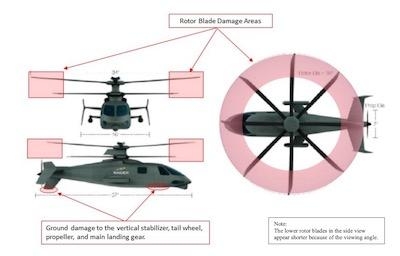Aircraft Experienced A Hard Landing While Hovering At The William P Gwinn Airport (06FA) In Jupiter, FL
The NTSB has released a factual report from a hard landing which occurred August 2, 2017, at about 0720 EDT involving an experimental Sikorsky S-97A, N971SK, that was hovering at the William P Gwinn Airport (06FA) in Jupiter, FL.

The aircraft sustained substantial damage during the test flight, however both airline transport-rated pilots sustained only minor injuries.
According to the report, the helicopter taxied to the runway hold short line for runway 9/27 at taxiway A (alpha), lifted into a low hover, and immediately experienced excessive roll oscillations which lead to intermeshing of the counter-rotating coaxial rotor system, and a hard landing. The flight crew shut down the helicopter, allowed the rotors to coast to a stop, and egressed the helicopter normally. Damage to the helicopter included collapsed landing gear, structural cabin damage, and dynamic component damage, including rotor blade tip separation of all 8 rotor blades.
The pilot-in-command told the NTSB he was in the right seat and manipulating the controls at the time of the accident. He stated that he applied collective to get the aircraft light on the wheels and then applied forward cyclic to initiate a roll forward (forward taxi). He ground taxied the aircraft to the runway just as he had done on other flights. He intended to hold short of the runway and wait to be notified that the SAR (search and rescue) aircraft was on station.
As the aircraft approached the runway, a slight left roll developed. The pilot decided to lift the helicopter into a 5-foot hover and stabilize. As he applied collective and got airborne the helicopter rolled quickly left and then right, continuing with 2-3 roll reversals of increasing roll attitudes eventually exceeding estimated 60 degrees angle of bank. The pilot applied counter roll control inputs, but roll rates experienced were excessive. After 2-3 roll reversals and after a large right angle of bank roll, as the helicopter reversed its roll, the pilot lowered the collective to full down to execute a landing.
After the landing, he shut the engine down, and completed the emergency shutdown procedure. He and the copilot egressed the helicopter normally.
The event occurred while taxiing on the runway with light weight on wheels, high collective pitch, and a slight forward cyclic pitch stick. Due to the light weight on wheels during the taxi, the flight control mode transitioned from ground mode to flight mode. The slight forward pitch stick in combination with flight mode initiated a nose down pitch rate.
The pilot took corrective action inputting aft cyclic stick to correct the nose down rate. The initial pitch axis correction led to a small initial left roll rate due to aircraft coupling. The pilot countered the small left roll rate with an appropriate magnitude right stick input. In conjunction with the right stick input, the pilot raised the collective to increase the altitude. The aircraft right roll response to the right stick input was larger than expected and the pilot countered with a large left stick input.
The aircraft left roll response was also larger than expected. The larger than expected roll response to the pilot roll stick input was the effect of a flight control system design error that resulted in unintended changes in the pilot input sensitivity in the roll axis during the transition from ground control mode to flight mode.
Sikorsky reported that the increased control sensitivity was never encountered in the initial piloted simulation evaluation, nor in the 15 subsequent aircraft flights after the flight control software revision was made. However, once the incident timeline was precisely determined, the increased sensitivity to pilot control input could be consistently replicated in the simulator.
(Image from NTSB report)
 Airborne 11.24.25: ANN's 30th!, Starships V3 Booster Boom, Earhart Records
Airborne 11.24.25: ANN's 30th!, Starships V3 Booster Boom, Earhart Records ANN FAQ: Submit a News Story!
ANN FAQ: Submit a News Story! Classic Aero-TV: DeltaHawk Aero Engine Defies Convention
Classic Aero-TV: DeltaHawk Aero Engine Defies Convention NTSB Final Report: Glasair GlaStar
NTSB Final Report: Glasair GlaStar ANN's Daily Aero-Term (11.22.25): Remote Communications Outlet (RCO)
ANN's Daily Aero-Term (11.22.25): Remote Communications Outlet (RCO)



